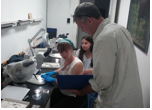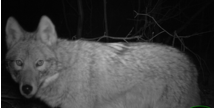HORACE MANN STUDENTS PARTICIPATE IN RESEARCH TO UNCOVER THE HABITS OF NYC COYOTES AND INVASIVE MILLIPEDES
NYC teens conducting original research at the American Museum of Natural History recently announced the results of separate studies evaluating two animals that many New Yorkers would be surprised to hear are making the metropolitan area home. As part of the Museum-led Science Research Mentoring Program (SRMP), local students researched the dietary habits of NYC coyotes and the expanding range of Boraria stricta, a millipede from the Southeast that is now invading Westchester County.
NYC Coyotes: What Are They Eating?
Coyote sightings around NYC have received a lot of media attention in the past year. While the city is among the most recent areas these animals have colonized, they are now breeding in the Bronx, transient in Manhattan and there is one known resident in Queens. In order to promote peaceful coexistence with the coyote population, Horace Mann student Rachel Lee (along with Manhattan & Brooklyn students Olivia Asher, Sandra Lewocki and Rita Pozovskiy) worked with Museum scientist Mark Weckel and Mammalogy Collections Manager Neil Duncan to analyze coyote scat collected from city parks. Among the findings, NYC coyotes are primarily eating small mammals and birds and there was even evidence of deer in samples collected from Pelham Bay Park.
Boraria Stricta: The Wayward Traveler
The harmful impact of invasive species on native wildlife and biodiversity is well known. In New York, a millipede species from the Southern Appalachian mountains was recently discovered in Westchester County, over 400 miles north of its home range. To better understand how these arthopods made it to the area, Horace Mann student and Bronx resident Mahir Ismail (along with Manhattan student Julian Perricone) worked alongside Museum scientist Anthony Caragiulo to examine the DNA of Boraria stricta. The team analyzed specimens collected in the Mianus River Gorge Preserve in Bedford, NY and found they were very genetically similar, suggesting a single introduction event rather then a natural migration from the South. The research is ongoing and Mahir and Julianne are encouraging citizen scientists to collect further specimens for analysis.




















Follow Us